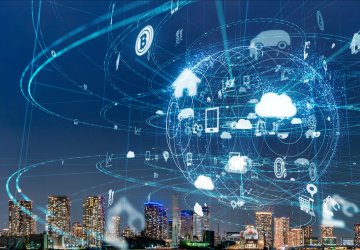In 2019 one of my colleagues, David Karpook, presented the question ‘Who owns the Building Internet of Things?’ His goal was to get a better understanding of the organisational consequences that digitalisation would bring to buildings in relation to real estate and facility management. In his blog, he rightly recognised that the roles and expertise of real estate and facility management would change as they begin to manage more of the digital, and not just the physical infrastructure of a building.
Sometimes I get the impression that ‘time’ in our world of technology is set at a faster pace. And I believe it’s already time to review the observations and questions that David Karpook posted just last year.
Let’s dive in.
Evolving roles keep up with the IoT
We see Prop Tech moving beyond the realms of IoT with sophisticated analytics applications and Artificial Intelligence (AI) becoming accessible and available at a device level. Speaking of AI at the device level, it is interesting to see that Apple acquired a low-power, edge-based* AI tooling company called Xnor.ai in January 2020.
The company specialises in technology that enables AI applications to be put directly onto devices, instead of devices calling upon a central AI application over the network. This way, the device-generated data can be processed by AI applications locally, making such devices really ‘smart.’ An interesting application in our field of RE and FM could be a camera sensor that identifies how many people are in a room or identify whether a desk is actually occupied.
When we look at these developments around the Building Internet of Things, perhaps the question of ‘who is responsible?’ is not an either/or question anymore. For instance, asset specialists in our field will need to obtain the IT skillset required to understand the deployment of Building Internet of Things items, such as sensors. But, they will also need to understand how they work and the maintenance required by this new generation of assets. These professionals will have dual roles: partly IT related, and partly asset/operations related.
In fact, this illustrates how incredibly interesting and challenging new jobs in our field will become for both experienced, open-minded professionals, and the younger generation just entering the field of facilities management.
Who is responsible when it affects multiple departments?
David Karpook provides a clear view on this question in his blog series about the Building Internet of Things. He discusses the change in relationships between RE & FM professionals and the COO/CIO office.
As Prop Tech moves forward and the digitisation of assets is reaching new levels around buildings, we also need to know what this means for the IT function within organisations.
The world of the CIO office and its IT departments is primarily defined by networks and applications/application platforms, all running on Cloud and other processing environments. Here, security and privacy toolsets are intrinsic elements.
In this world, IT departments typically have full control over these environments and (change) management is purely a virtual activity, as software can easily be upgraded or reallocated within the IT infrastructure. No problem.
However, this control changes fundamentally when ‘applications’ become inseparable from devices that perform non-IT functions in the infrastructures of buildings. For instance, in the smart camera sensor example mentioned before, think about HVAC systems of a future generation that will combine device-level AI with the actual management of temperature and climate for a building in real time.
In this new ‘composite-world’ we are moving towards, the IT function is no longer able to manage the IT-infrastructure on its own, and lacks insight into consequences in the physical domain when performing interventions on the digital side of these assets. So, it is not only the FM function, but also the IT function that will be impacted equally at its core. Looking ahead to managing these ‘composite-infrastructures,’ the pure IT function might become responsible for providing an IT landscape (including standardisation regulations and technology standards requirements) that will enable FM professionals to select, deploy and use new generations of really smart assets in safe, secure, and productive ways, fitting into the IT landscapes as provided by the IT function.
Other options may also arise as new approaches to these functions emerge over time. In any case, a fundamental conversation about the future relationships between the IT business function and the RE/FM business function is eminent and important for future developments – not only to evolve the future of the two business functions themselves, but also to develop the future of the organisations they help operate.
*Edge computing is a distributed computing paradigm that brings computation and data storage closer to the devices where it’s being gathered

